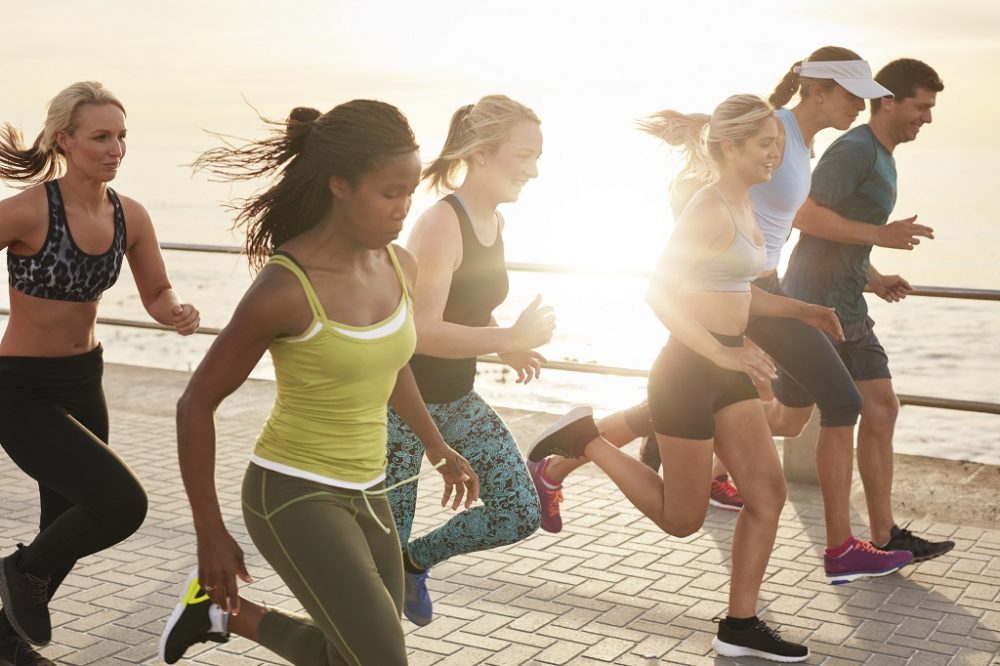
Keep in mind, variety is the spice of life, so enjoy rock climbing, Rollerblading, cycling, hiking, jogging, or skiing with friends, which are excellent ways to stay socially active and keep the body fit.
Experts say cross training or adding variety to your training routine is a much better approach towards fitness. All sorts of professional athletes, from ball players to golfers, tennis players to swimmers, make cross training part of their regimes. Cross training helps you to pay attention to all the muscles in your body that are involved, not just the ones directly related to a particular sport or activity.
Sporty Options to Cross-Train
- Rock Climbing: If you are interested in improving your cardiovascular health, toning muscles, or losing weight, rock climbing may be just what the doctor ordered! Rock climbing done at a moderate intensity for around one hour will burn around 400 calories. Climbers quickly begin to develop arm, back, finger, and core strength as a result of the many reaches and holds that are repeated over and over through the completion of one climb. Climbers are successful with more difficult ascents only after working to improve the strength and endurance of their calves, shoulders, and core; their agility; strength-to-weight ratio; and flexibility in hips and hamstrings. Rock climbing is an excellent sport to participate in to increase your level of fitness.

- Rollerblading: According to University of Wisconsin Medical School assistant professor Carl Foster, rollerblading provides a dynamic workout that can help burn more calories than running or cycling, build more muscle than those two activities and is also comparable as an aerobic exercise. In interval skating, you skate hard in the tuck position for 1 minute and skate upright in a more relaxed manner the next minute. Skating in this manner burns about 450 calories in 30 minutes. Another, study conducted at the Human Performance Laboratory at St. Cloud State University in Minnesota found that inline skating develops muscles in the entire upper leg, rear end and hip, as well as lower back. Muscles in the upper arms and shoulders are also developed when arms are swung vigorously while skating.
- Hiking: It is a wonderful activity that is easy to start with friends and continue, due to its varied and customizable nature. Outdoor hiking can help you to lose weight, clear and ease your mind and build a healthier body. Hiking tends to put pressure on your bones, and encourages healthy bone structure and reduces the chances of osteoporosis. Being exposed to sunshine also increase your levels of vitamin D. Hiking can serve cardiovascular benefits, depending on how hard you push yourself during a hike.
- Skiing: A ski holiday is usually an unforgettable experience. Skiing is an effective cardiovascular and strength-building workout. It primarily exercises your lower body, but your core and upper body will benefit as well. One hour of downhill skiing can burn 450 to 600 calories for an average 165-pound person, whereas cross-country can burn 600 to 675 calories (which is equivalent to running five miles or an hour of lap swimming). Both forms of skiing also buildbalance, coordination and flexibility.
- Jogging: Regular jogging gives better overall physical condition as well as some other health benefits, including mental benefits such as relaxation and reduction of anxiety. Jogging helps to reduce stubborn belly fat. Jogging can be performed in a lot of ways. Long distance jogging generally covers 6-20 km, at a moderate speed on even roads or paths. Short distance jogging covers 3-6 km in a faster pace. Jogging upwards in a steep terrain 3-4 km, in a speed adjusted to the steepness. Jogging in a hilly terrain with paths going both up and down 4-8 km. Click here, for a sample jogging program.
- Indoor Cycling: Indoor cycling is going through its own mini revolution at the moment with classes like adidas Zone Cycling taking inspiration from Olympians Sir Chris Hoy and Victoria Pendleton. You can now disco cycle, combine your cycle class with small free weights, and even race against your class competitors with the latest in interactive technology. Cycling is no longer just about the trainer, the music and the bike – it now has added atmosphere and the ‘fun factor’, thanks in large part to a variety of formats and new technology.
- Fencing: This is an exciting mental and physical exercise. With its intense arm and footwork, fencing burns calories and improves speed, flexibility and coordination while toning the buttocks, stomach and thigh muscles. Age should not be a concern. According to Jim Philbin, former Commonwealth sabre champion and coach at the Salle Paul club in north London, “You are never too old to start. Veterans’ fencing – over-40s – is one of the fastest-growing age groups in the sport.”
When a physical activity has fun aspect you’re more likely to make it a habit because it doesn’t feel like exercise,” says Ottawa exercise specialist Jennifer Greger. “Trying a new activity will also work your body and your cardiovascular system in a different way than your regular routine so you’ll see better results, especially if you do it at least twice a week.”
Get started to add a little variety to your current routine, we promise you’ll have a blast while burning calories with these fun activities.